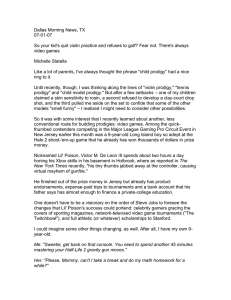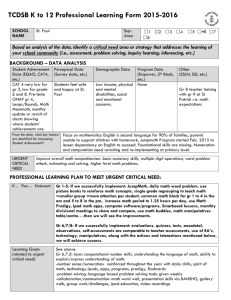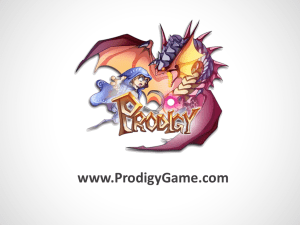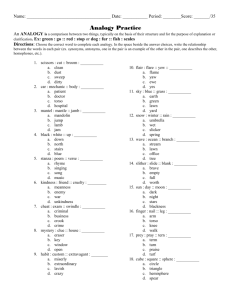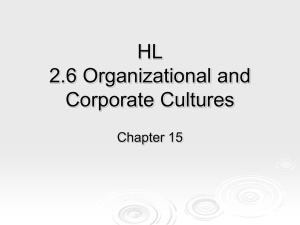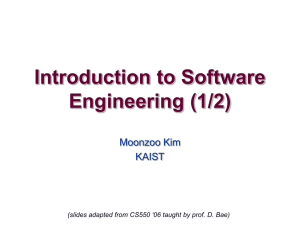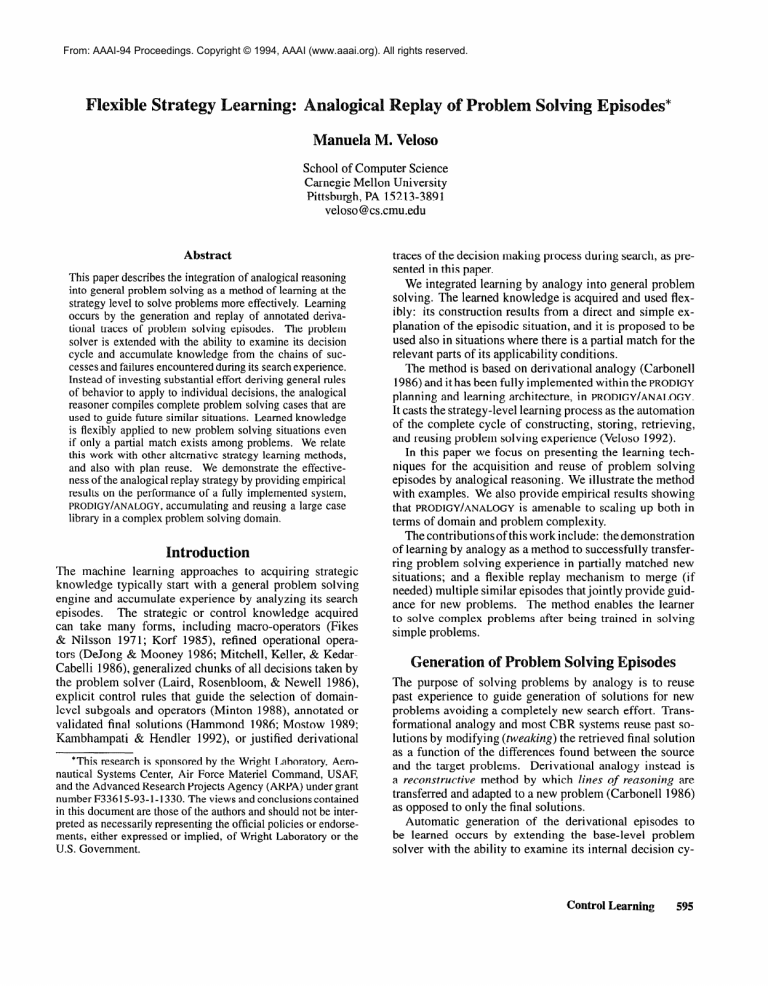
From: AAAI-94 Proceedings. Copyright © 1994, AAAI (www.aaai.org). All rights reserved.
alogic
ay of
Manuela M. Veloso
School of Computer Science
Carnegie Mellon University
Pittsburgh, PA 15213-3891
veloso@cs.cmu.edu
Abstract
This paper describes the integration of analogical reasoning
into general problem solving as a method of learning at the
strategy level to solve problems more effectively. Learning
occurs by the generation and replay of annotated derivational traces of problem solving episodes.
The problem
solver is extended with the ability to examine its decision
cycle and accumulate knowledge from the chains of successes and failures encountered during its search experience.
Instead of investing substantial effort deriving general rules
of behavior to apply to individual decisions, the analogical
reasoner compiles complete problem solving cases that are
used to guide future similar situations. Learned knowledge
is flexibly applied to new problem solving situations even
if only a partial match exists among problems.
We relate
this work with other alternative strategy learning methods,
and also with plan reuse. We demonstrate the effectiveness of the analogical replay strategy by providing empirical
results on the performance of a fully implemented system,
PRODIGY/ANALOGY,
accumulating and reusing a large case
library in a complex problem solving domain.
Introduction
The machine learning approaches to acquiring strategic
knowledge typically start with a general problem solving
engine and accumulate experience by analyzing its search
episodes.
The strategic or control knowledge acquired
can take many forms, including macro-operators
(Fikes
& Nilsson 197 1; Korf 1985), refined operational operators (DeJong & Mooney 1986; Mitchell, Keller, & KedarCabelli 1986), generalized chunks of all decisions taken by
the problem solver (Laird, Rosenbloom, & Newell 1986),
explicit control rules that guide the selection of domainlevel subgoals and operators (Minton 1988), annotated or
validated final solutions (Hammond 1986; Mostow 1989;
Kambhampati
& Hendler 1992), or justified derivational
*This research is sponsored by the Wright Laboratory, Aeronautical Systems Center, Air Force Materiel Command, USAF,
and the Advanced Research Projects Agency (ARPA) under grant
number F336 1593- 1- 1330. The views and conclusions contained
in this document are those of the authors and should not be interpreted as necessarily representing the official policies or endorsements, either expressed or implied, of Wright Laboratory or the
U.S. Government.
traces of the decision making process during search, as presented in this paper.
We integrated learning by analogy into general problem
solving. The learned knowledge is acquired and used flexibly: its construction results from a direct and simple explanation of the episodic situation, and it is proposed to be
used also in situations where there is a partial match for the
relevant parts of its applicability conditions.
The method is based on derivational analogy (Carbone11
1986) and it has been fully implemented within the PRODIGY
planning and learning architecture, in PRODIGY/ANALOGY.
It casts the strategy-level learning process as the automation
of the complete cycle of constructing, storing, retrieving,
and reusing problem solving experience (Veloso 1992).
In this paper we focus on presenting the learning techniques for the acquisition and reuse of problem solving
episodes by analogical reasoning. We illustrate the method
with examples. We also provide empirical results showing
that PRODIGY/ANALOGYis amenable to scaling up both in
terms of domain and problem complexity.
The contributions of this work include: the demonstration
of learning by analogy as a method to successfully transferring problem solving experience in partially matched new
situations; and a flexible replay mechanism to merge (if
needed) multiple similar episodes that jointly provide guidance for new problems.
The method enables the learner
to solve complex problems after being trained in solving
simple problems.
eration of
lern Solving Episo
The purpose of solving problems by analogy is to reuse
past experience to guide generation of solutions for new
problems avoiding a completely new search effort. Transformational analogy and most CBR systems reuse past solutions by modifying (tweakirzg) the retrieved final solution
as a function of the differences found between the source
and the target problems.
Derivational analogy instead is
a reconstructive method by which lines of reasoning are
transferred and adapted to a new problem (G-bone11 1986)
as opposed to only the final solutions.
Automatic generation of the derivational
episodes to
be learned occurs by extending the base-level problem
solver with the ability to examine its internal decision cy-
Control Learning
595
cle, recording the justifications
for each decision during
its search process. We used NOLIMIT (Veloso 1989), the
first nonlinear and complete problem solver of the PRODIGY
planning and learning system, as the base-level problem
solver.’ Throughout the paper, NOLIMIT refers to the baselevel planner and PRODIGY/ANALOGY
refers to the complete
analogical reasoner with the capabilities to generate, store,
retrieve, and replay problem solving episodes.
NOLIMIT’S planning reasoning cycle involves several decision points, namely: the goal to select from the set of
pending goals; the operator to choose to achieve a particular goal; the bindings to choose in order to instantiate the
chosen operator; apply an operator whose preconditions are
satisfied or continue subgoaling on a still unachieved goal.
PRODIGY/ANALOGYextends NOLIMIT withthecapabilityof
recording the context in which the decisions are made. Figure 1 shows the skeleton of the decision nodes. We created
a language for the slot values to capture the reasons that
support the choices (Veloso & Carbonell 1993a).
Goal Node
Chosen Op Node
:step
:sibling-goals
:sibling-appl-ops
:why-subgoal
:why-this-goal
:precond-of
:step
:sibling-ops
:why-this-op
:relevant-to
Applied Op Node
:step
:sibling-goals
:sibling-appl-ops
:why-apply
:why-this-op
:chosen-at
Figure 1: Justification record structure. Nodes are instantiated at decision points during problem solving.
Each
learned episode is a sequence of such justified nodes.
There are mainly three different kinds of justifications:
links among choices capturing the subgoaling structure
(slots precond-of
and relevant-to), records of explored failed alternatives (the sibling- slots), and pointers
to any applied guidance (the why- slots). A stored problem
solving episode consists of the successful solution trace augmented with these annotations, i.e., the derivational trace.
Example
We use examples from a logistics transportation domain introduced in (Veloso 1992). In this domain packages are
to be moved among different cities. Packages are carried
within the same city in trucks and between cities in airplanes. At each city there are several locations, e.g., post
offices and airports. The problems used in the examples
are simple for the sake of a clear illustration of the learning process. Later in the paper we comment briefly on the
complexity of this domain and show empirical results where
PRODIGY/ANALOGYwas tested with complex problems.
Consider the problem illustrated in Figure 2. In this
problem there are two objects, ob4 and ob7, one truck tr9,
There is one city c3 with a post
and one airplane pll.
office p3 and an airport a3. In the initial state, ob4 is at p3
and the goal is to have ob4 inside of tr9.
‘NOLIMIT was succeeded by the current planner, PRODIGY~.~
(Carbonell
1994).
596
& the Prodigy Research Group 1992; Fink & Veloso
Machine Learning
(state (and
(at-obj ob4 p3)
(at-obj ob7 a3)
(at-truck tr9 a3)
(at-airplane pll a3)
(same-city a3 ~3))
(goal
(inside-truck
ob4 n-9))
Figure 2: Example: The goal is to load one object into the
truck. Initially the truck is not at the object’s location.
The solution to this problem is to drive the truck from the
airport to the post office and then load the object.
There are two operators that are relevant for solving
this problem.(The complete set of operators can be found
in (Veloso 1992).) The operator LOAD-TRUCK
specifies that
an object can be loaded into a truck if the object and the truck
are at the same location, and the operator DRIVE-TRUCK
states that a truck can move freely between locations within
the same city.
Figure 3 (a) shows the decision tree during the search for
the solution. Nodes are numbered in the order in which the
search space is expanded. The search is a sequence of goal
choices followed by operator choices followed occasionally
by applying operators to the planner’s internal state when
their preconditions are true in that state and the decision for
immediate application is made.
nl
(inside-truck
ob4 tr9)
n8
I
(load-truck
ob4t9p3)
T
n9
(at-truck
tr9 3)
n10
.._ P
(drive-truck
tr9 p3)
nil
P
APPLY
(drive-truck
‘h-9 a p3)
n12
?
APPLY
(load-truck
ob4 tr9 p3)
j (inside-truck ob4 tr9)
: :precond-of user
,..........-.i.-.--------l
i
:
cn2............:............
1
(load-truck
ob4 t 9 a3)
i
n3 (at-obj
ob4,a3)
n4
(unEb;d-Erpane
n5
9
(inside-airplane
tr9 ull)
n6
1
(load-airplane
ob4 ~11 a3)
-1
Failure
goal-loop
(at-obj
ob4 a3)
>
(unload-truck
ob4 t 9 a3)
r
Failure
goal-loop
(inside-trick
ob4 tr9
i (load-truck ob4 tr9 p3) i
: :relevant-to cnl
:
i :sibling-ops
f ((load-truck ob4 tr9 a3)i
: (goal-loop
: (inside-truck ob4 tr9) i
j (at-obj ob4 a3)))
’ !
,............;........---1
cn3.-...........:............
; (at-truck tr9 p3)
: :precond-of cn2
,-...........~.-.-----...f
cn4... _________.i....
i
:
____~-.;
; (drive-truck tr9 a3 p3) ;
: :relevant-to cn3
:
I____
-____.-
_,____-_
-----
-2
cn5 ,_.__________c---_--------
i APPLY
: (drive-truck tr9 a3 p3) :
,............i----.‘.....I
cd. ____________: ____________
; APPLY
: (load-truck ob4 tr9 a3) i
,.........--...........-.1
(4
(b)
Figure 3: (a) The search tree to solve the problem in Figure 2
- the numbering of the nodes shows the search order; (b) The
corresponding learned problem solving episode to be stored
(only a subset of the justifications is shown).
This trace illustrates PRODIGY handling multiple choices
of how to instantiate operators.
There are two instantiations of the operator load-truck that are relevant to
the given goal, i.e., the instantiations
(load-truck ob4
tr9 p3) and (load-truck ob4 tr9 a3) addthegoal
(inside- truck ob4 tr9 ) . An object can be loaded into
a truck at both post office and airport locations. Node n2
shows that the alternative of loading the truck at the airport
a3 is explored first. This leads to two failed paths. The
solution is found after backtracking to the alternative child
of node nl. Nodes n8 through n12 show the final sequence
n8 shows the correct choice of
of successful decisions.
loading the truck at the post office, where ob4 is located.
The solution corresponds to the two steps applied at nodes
nil and n12: the truck tr9 is driven from a3 to p3, as
chosen at node n8 and then it is loaded with ob4.2
Figure 3 (b) shows the case generated from the problem
solving episode shown in Figure 3 (a). The entire search
tree is not stored in the case, but only the decision nodes
of the final successful path. The subgoaling structure and
the record of the failures are annotated at these nodes. Each
goal is a precondition of some operator and each operator is
chosen and applied because it is relevant to some goal that
needs to be achieved. The failed alternatives are stored with
an attached reason of failure.
As an example, node cn2 corresponds to the search tree
node n8. This search node has a sibling alternative n2
which was explored and failed. The failed subtree rooted
at n2 has two failure leaves, namely at n6 and n7. These
failure reasons are annotated at the case node cn2. At replay
time these justifications are tested and may lead to an early
pruning of alternatives and constrain possible instantiations.
eplay of Multiple Guiding Cases
When a new problem is proposed, PRODIGY/ANALOGY retrieves from the case library one or more problem solving
episodes that may partially cover the new problem solving
situation. The system uses a similarity metric that weighs
goal-relevant features (Veloso & Carbonell 1993b). In a
nutshell, it selects a set of past cases that solved subsets of
the new goal statement. The initial state is partially matched
in the features that were relevant to solving these goals in
the past. Each retrieved case provides guidance to a set of
interacting goals from the new goal statement. At replay
time, a guiding case is always considered as a source of
guidance, until all the goals it covers are achieved.
The general replay mechanism involves a complete interpretation of the justification structures annotated in the past
cases in the context of the new problem to be solved. Equivalent choices are made when the transformed justifications
hold. When that is not the situation, PRODIGY/ANALOGY
plans for the new goals using its domain operators adding
new steps to the solution or skipping unnecessary steps from
the past cases. Table 1 shows the main flow of control of
the replay algorithm.
The replay functionality transforms the planner, from a
module that costly generates possible operators to achieve
*Note that domain-independent
methods to try to reduce the
search effort (Stone, Veloso, & Blythe 1994) in general do not
capture domain specific control knowledge, which must be then
acquired by learning.
1. Terminate if the goal is satisfied in the state.
2. Choose a step from the set of guiding cases or decide if there
is need for additional problem solving work. If a failure is
encountered, then backtrack and continue following the guiding
cases at the appropriate steps.
3. If a goal from a past case is chosen, then
3.1 Validate the goal justifications. If not validated, go to step2.
3.2 Create a new goal node; link it to the case node. Advance
the case to its next decision step.
3.3 Select the operator chosen in the case.
3.4 Validate the operator and bindings choices. If not validated,
base-level plan for the goal. Use justifications and record of
failures to make a more informed new selection. Go to step 2.
3.5 Link the new operator node to the case node. Advance the
case to its next decision step.
3.6 Go to step 2.
4. If an applicable operator from a past case is chosen, then
4.1 Check if it can be applied also in the current state. If it
cannot, go to step 2.
4.2 Link the new applied operator node to the case node. Advance the case to its next decision step.
4.3 Apply the operator.
4.4 Go to step 1.
Table 1: The main flow of control of the replay procedure.
the goals and searches through the space of alternatives
generated, into a module that tests the validity of the choices
proposed by past experience and follows equivalent search
The replay procedure provides the following
directions.
benefits to the problem solving procedure as shown in the
procedure of Table 1.
Proposal and validation of choices versus generation and
search of alternatives (steps 2, 3.1, 3.3, 3.4, and 4.1).
Reduction of the branching factor - past failed alternatives are pruned by validating the failures recorded
in the past cases (step 3.4); if backtracking is needed
PRODIGY/ANALOGY backtracks also in the guiding cases
- through the links established at steps 3.2, 3.5 and 4.2 and uses information on failure to make more informed
backtracking decisions.
Subgoaling links identify the subparts of the case to replay
-the steps that are not part of the active goals are skipped.
The procedure to advance the cases, as called in steps 3.2,
3.5 and 4.2, ignores the goals that are not needed and their
corresponding planning steps.
PRODIGY/ANALOGY constructs a new solution from a Set
of guiding cases as opposed to a single past case. Complex
problems may be solved by resolving minor interactions
among simpler past cases. However, following several
cases poses an additional decision making step of choosing which case to pursue. We explored several strategies
to merge the guidance from the set of similar cases. In
the experiments from which we drew the empirical results
Control Learning
597
presented below, we used an exploratory merging strategy.
Choices are made arbitrarily when there is no other guidance
available. This strategy allows an innovative exploration of
the space of possible solutions leading to opportunities to
learn from new goal interactions or operator choices.
Example
Figure 4 shows a new problem and two past cases selected
for replay. The cases are partially instantiated to match the
new situation. Further instantiations occur while replaying.
.~___________._____.___._____.____..
: cnl - goal
i (inside-ai
:
lane ob3 ~15)
i cn2 - op
Past cases
New nroblem
! (goal (inside-airplane ob3 ~15))
i
i (relevant-state (at-obj ob3 cap3>) i
a12))
:
:.................... (at-airplanepl5
___.-_ _._._..______.*
,.-.-.-.-.-.-.-.._---...__-.-..____.-.-.____.
i (goal (inside-truck ob8 tr2))
/
i (relevant-state
(at-obj ob8 p4)
(at-airplane
i
(at-truck tr2 cap7>))
:
-._.___._.-.-.___._____.___.___.
__________.-
Uog$;t;~$y,yob3
~15a41
i cn3 - goal
j (at-airplane ~15 a4)
; :precond-of cn2
i cn5 -APPLY
d-
i (fly-airplane ~15 al2 a4)
j
i cn4 - op
i Iwhy-this-op(applicable)
n5 -APPLY
i
(fly-airplane
I
,-
: (load-airplane ob3 ~15 a4)
..______-_____._______---_____--___.
,~_._._________._._____._._____._._~
p15 a12)
Figure 5 shows the replay episode to generate a solution
to the new problem. The new situation is shown at the right
side of the figure and the two past guiding cases at the left.
The transfer occurs by interleaving the two guiding cases,
performing any additional work needed to accomplish remaining subgoals, and skipping past work that does not
need to be done. In particular, the case nodes cn3 ’ through
cn5 I are not reused, as there is a truck already at the post
office in the new problem. The nodes ng-14 correspond
to unguided additional planning done in the new episode.3
prunes out an alternative
At node n7, PRODIGY/ANALOGY
operator, namely to load the truck at any airport, because
of the recorded past failure at the guiding node cn2 I. The
recorded reason for that failure, namely a goal-loop with
the (inside-truck ob8 tr2 1, is validated in the new
situation, as that goal is in the current set of open goals, at
node n6. Note that the two cases are merged using a bias to
postpone additional planning needed. Different merges are
possible.
Empirical Results
We ran and accumulated in the case library a set of 1000
problems in the logistics transportation domain. In the experiments the problems are randomly generated with up to
20 goals and more than 100 literals in the initial state. The
case library is accumulated incrementally while the system
solves problems with an increasing number of goals.
The logistics transportation is a complex domain. In particular, there are multiple operator and bindings choices for
each particular problem, and those choices increase considerably with the size or complexity of the problem. For
example, for the goal of moving an object to an airport,
3Note that extra steps may be inserted at any point, interrupting
and interleaving the past cases, and not just at the end of the cases.
Machine Learning
n2 - op
p15 al2 a4)
n6 - goal
(inside-truck ob8 tr2)
:precond-of user
i cn6 - APPLY
Figure 4: Instantiated past cases cover the new goal and
partially match the new initial state. Some of the case
variables are not bound by the match of the goals and state.
598
)
:relevant-to cnl
:sibling-ops
((load-airplane ob3 ~15 a12)
(goal-loop (inside-airplane
i3-;~-!~;,'3~5
a12a4
,.---._._--.-._.__--______.._______._________
lane ob3 ~15)
:precond-o P user
i (load-airplane ob3 ~15 a4)
.
i
j
;
nl - goal
(inside-air
: :precond-otpuser
n8 - APPLY
: cnl ’-goal
(load-truck ob8 tr2 p4)
i (inside-truck ob8 tr2)
: :precond-of user
n9 - goal
(at-obj ob3 a4)
:precond-of n2
: cn2’-op
i (load-truck ob8 tr2 p4)
:
:
i
i
:relevant-to cnl ’
:sibling-ops
((load-truck ob8 tr2 <ap7>)
(goal-loop (inside-truck ob8 tr2)))
nlO- op
(unload-truck
:relevant-to n9
i
ob3 tr2 a4)
nil - goal
(at-truck tr2 a4)
:precond-of n10
i cn3’ - goal
: (at-truck tr2 p4)
: :precond-of cn2 ’
i cn4’-op
: (drive-truck tr2 <ap7> p4)
n13 -APPLY
: :relevant-to cn3’
! cn5’ -APPLY
i (drive-truck tr2 <ap7> p4)
i cn6’ -APPLY
(drive-truck tr2 p4 a4)
--I
--
: (load-truck ob8 tr2 p4)
j
._____________________.____________,
Figure 5: Derivational
n14 -APPLY
(unload-truck
ob3 tr2 a4)
n15 - APPLY
(load-airplane
ob3 ~15 a4)
replay of multiple cases.
the problem solver does not have direct information from
the domain operators on whether it should move the object
inside of a truck or an airplane. Objects can be unloaded
at an airport from both of these carriers, but trucks move
within the same city and airplanes across cities. So if the
object must go to an airport within the same city where it is,
it should be moved in a truck, otherwise it should be moved
in an airplane. The specification of these constraints is embedded in the domain knowledge and not directly available.
The city at which the object is located is not immediately
known, as when the object is inside of a carrier or a building,
its city location is specified indirectly. PRODIGY/ANALOGY
provides guidance at these choices of operators and bindings through the successful and failed choices annotated in
past similar problem solving episodes.
PRODIGY/ANALOGY
increases the solvability horizon of
the problem solving task: Many problems that NOLIMIT
cannot solve within a reasonable time limit are solved
by PRODIGY/ANALOGY
within that limit.
Figure 6 (a)
plots the number of problems solved by NOLIMIT and
PRODIGY/ANALOGY
for different CPU time bounds.
NOLIMIT solves only 458 problems out of the 1000 problems
even when the search time limit is increased up to 350s.
I
:
-
D- - e NoLimit
H
Prodigy/Analogy
b 500
/H-c
_____----------
4
200~/
~200000
.s
z
; 150000
a
I
Q- - e NoLimit
H
Prodigy/Analogy
s 700000
0”
W-W NoLimit
M
Prodigy/Analogy
100.:
Oi
z! 8000
3
6000
E
c*-
‘u
7-h
7&J au i&J 3bu iu
40
Time Bound (seconds)
Number of Problems (solved)
(a>
0-Q
Number of Problems (all)
03
Figure 6: (a) Number of problems solved from a set of 1000 problems versus different running time bounds. With a time
limit of 350s NOLIMIT solves only 458 problems, while PRODIGY/ANALOGYsolves the complete set of 1000 problems;
(b) Cumulative running times for the 458 problems solved by both configurations; (c) Cumulative running times for all the
1000 problems. The problems unsolved by NOLIMIT count as the maximum time limit given (350s).
This graph shows a significant improvement achieved by
solving problems by analogy with previously solved problems. Although not shown in this figure, the percentage of
problems solved without analogy decreases rapidly with the
complexity of the problems. The gradient of the increase
in the performance of PRODIGY/ANALOGYover the baselevel NOLIMIT shows its large advantage when increasing
the complexity of the problems to be solved.
In other previous work, comparisons between the performance of a problem solver before and after learning control
knowledge were done by graphing the cumulative running
times of the two systems over a set of problems. Figure 6 (b)
shows the cumulative running time for the set of problems
(458) that were both solved by both configurations.
The
graph shows a final factor of 3.6 cumulative speed up of
PRODIGY/ANALOGYover the base NOLIMIT. (The maximum individual speed up was of a factor of approximately
40.) In Figure 6 (c) we extend this comparison to account
also for the unsolved problems (similarly to what was done
in previouscomparisons
(Minton 1988)). For each unsolved
problem, we add the running time bound.
We also compiled results on the length of the solutions generated by PRODIGY/ANALOGYand on the impact
of the size of the case library in the retrieval time (Veloso
1992). We concluded that PRODIGY/ANALOGYproduces solutions of equal or shorter length in 92% of the problems.
PRODIGY/ANALOGY
includes an indexing mechanism for the
case library of learned problem solving episodes (Veloso &
Carbonell 1993b). We verified that with this memory organization, we reduced (or avoided) the potential utility problem (Doorenbos & Veloso 1993): The retrieval time suffers
no significant increase with the size of the case library.
Discussion and related work
PRODIGY’Sproblem
solving method is a combination of
means-ends analysis, backward chaining, and state-space
search. PRODIGYcommits to particular choices of operators,
bindings, and step orderings as its search process makes use
of a uniquely specified state while planning (Fink & Veloso
1994). PRODIGY’Slearning opportunities are therefore directly related to the choices found by the problem solver
in its state-space search. It is beyond the scope of this
paper to discuss what are the potential advantages or disadvantages of our problem solving search method in particular compared with other planners that search a plan space.
Any system that treats planning and problem solving as a
search process will make a series of commitments during
search. The pattern of commitments
made will produce
greater efficiency in some kinds of domains and less in others (Stone, Veloso, & Blythe 1994). The goal of strategy
learning is precisely to automate the process of acquiring
operational knowledge to improve the performance of a particular base-level problem solving reasoning strategy. Each
particular problem solver may find different learning opportunities depending on its reasoning and searching strategies.
However, the following aspects of this work may apply to
other problem solvers: learning a chain of justified problem solving decisions as opposed to individual ones or final
solutions; and flexibly replaying multiple complementary
learned knowledge in similar situations as opposed to identical ones.
This work is related to other plan reuse work in the
plan-space search paradigm, in particular (Kambhampati
& Hendler 1992). In that framework, it proved beneficial
to reuse the final plans annotated with a validation structure
that links the goals to the operators that achieve each goal.
In PRODIGY/ANALOGY
we learn and replay the planner’s decision making process directly. The justification structures
in the derivational traces also encompass the record of past
failures in addition to the subgoaling links as in (Mostow
1989; Blumenthal 1990; Kambhampati & Hendler 1992;
Bhansali & Harandi 1993). The derivational traces provide
guidance for the choices that our problem solver faces while
constructing solutions to similar problems. Adapted decisions can be interleaved and backtracked upon within the
replay procedure.
Control Learning
599
Learning by analogy can also be related to other strategies
to learn control knowledge.
In particular analogical reasoning in PRODIGYcan be seen as relaxing the restrictions
to explanation-based
approaches as developed in PRODIGY
(Minton 1988; Etzioni 1993). Instead of requiring complete axiomatic domain knowledge to derive general rules
of behavior for individual decisions, PRODIGY/ANALOGY
compiles annotated traces of solved problems with little
post processing. The learning effort is done incrementally
on an “if-needed” basis at storage, retrieval and adaptation
time. The complete problem solving episode is interpreted
as a global decision-making
experience and independent
subparts can be reused as a whole. PRODIGY/ANALOGY
can replay partially matched learned experience increasing
therefore the transfer of potentially over-specific learned
knowledge.
Chunking in SOAR (Laird, Rosenbloom, & Newell 1986)
also accumulates episodic global knowledge.
However,
the selection of applicable chunks is based on choosing the
ones whose conditions match totally the active context. The
chunking algorithm in SOAR can learn interactions among
different problem spaces.
Analogical reasoning in PRODIGY/ANALOGYlearns complete sequences of decisions as opposed to individual rules.
Under this perspective analogical reasoning shares characteristics with learning macro-operators
(Yang & Fisher
1992). Intermediate decisions corresponding to choices internal to each case can be bypassed or adapted when their
justifications do not longer hold. Furthermore cases cover
complete problem solving episodes and are not proposed at
local decisions as search alternatives to one-step operators.
Conclusion
Reasoning by analogy in PRODIGY/ANALOGY
consists of the
flexible reuse of derivational traces of previously solved
problems to guide the search for solutions to similar new
problems. The issues addressed in the paper include: the
generation of problem solving cases for reuse, and the flexible replay of possibly multiple learned episodes in situations that partially match new ones. The paper shows results
that empirically validate the method and demonstrate that
PRODIGY/ANALOGYis amenable to scaling up both in terms
of domain and problem complexity.
Acknowledgements
Special thanks to Jaime Carbonell for
his guidance, suggestions, and discussions on this work.
Thanks also to Alicia Perez and the anonymous reviewers
for their helpful comments on this paper.
References
Bhansali, S., and Harandi, M. T. 1993. Synthesis of UNIX
programs using derivational analogy. Machine Learning 10.
Blumenthal, B. 1990. Replaying episodes of a metaphoric application interface designer. Ph.D. Dissertation, University of
Texas, Artificial Intelligence Lab, Austin.
Carbonell, J. G., and the Prodigy Research Group.
1992.
PRODIGY4.0: The manual and tutorial. Technical Report CMUCS-92-150, SCS, Carnegie Mellon University.
600
Machine Learning
Carbonell, J. G. 1986. Derivational analogy: A theory of reconstructive problem solving and expertise acquisition. In Michalski,
R. S.; Carbonell, J. G.; and Mitchell, T. M., eds., Machine Learning, An Artificial Intelligence Approach, Volume II, 371-392.
Morgan Kaufman.
DeJong, G. F., and Mooney, R. 1986. Explanation-based
leaming: An alternative view. Machine Learning l(2): 145-l 76.
Doorenbos, R. B., and Veloso, M. M. 1993. Knowledge organization and the utility problem. In Proceedings of the Third
International Workshop on Knowledge Compilation and Speedup
Learning, 28-34.
Etzioni, 0. 1993. Acquiring search-control
analysis. Artificial Intelligence 65.
knowledge
via static
Fikes, R. E., and Nilsson, N. J. 1971. Strips: A new approach to
the application of theorem proving to problem solving. Artificial
Intelligence 2: 189-208.
Fink, E., and Veloso, M. 1994. Formalizing the PRODIGY
planning algorithm. Technical Report CMU-CS-94- 112, School
of Computer Science, Carnegie Mellon University.
Hammond, K. J. 1986. Case-based Planning: An Integrated
Theory of Planning, Learning and Memory. Ph.D. Dissertation,
Yale University.
Kambhampati, S ., and Hendler, J. A. 1992. A validation based
theory of plan modification and reuse. Artificial Intelligence
55(2-3): 193-258.
Korf, R. E. 1985. Macro-operators:
Artificial Intelligence 26:35-77.
A weak method for learning.
Laird, J. E.; Rosenbloom, P. S.; and Newell, A. 1986. Chunking in
SOAR: The anatomy of a general learning mechanism. Machine
Learning 1: 1 l-46.
Minton, S. 1988. Learning EfSective Search Control Knowledge: An Explanation-Based Approach. Boston, MA: Kluwer
Academic Pubnshers.
Mitchell, T. M.; Keller, R. M.; and Kedar-Cabelli, S. T. 1986.
Explanation-based
generalization:
A unifying view. Machine
Learning 1:47-80.
Mostow, J. 1989. Automated replay of design plans: Some issues
in derivational analogy. Artificial Intelligence 40( l-3).
Stone, P.; Veloso, M.; and Blythe, J. 1994. The need for different
domain-independent
heuristics. In Proceedings of the Second
International Conference on AI Planning Systems.
Veloso, M. M., and Carbonell, J. G. 1993a. Derivational analogy
in PRODIGY: Automating case acquisition, storage, and utilization. Machine Learning 10:249-278.
Veloso, M. M., and Carbonell, J. G. 1993b. Towards scaling
up machine learning: A case study with derivational analogy in
PRODIGY.
In Minton, S., ed., Machine Learning Methods for
Planning. Morgan Kaufmann. 233-272.
Veloso, M. M. 1989. Nonlinear problem solving using intelligent
casual-commitment.
Technical Report CMU-CS-89-210, School
of Computer Science, Carnegie Mellon University.
Veloso, M. M. 1992. Learning by Analogical Reasoning in General Problem Solving. Ph.D. Dissertation, School of Computer
Science, Carnegie Mellon University, Pittsburgh, PA. Available
as technical report CMU-CS-92-174. A revised version of this
manuscript is in press to be published by Springer Verlag.
Yang, H., and Fisher, D. 1992. Similarity-based retrieval and
partial reuse of macro-operators.
Technical Report CS-92- 13,
Department of Computer Science, Vanderbilt University.

